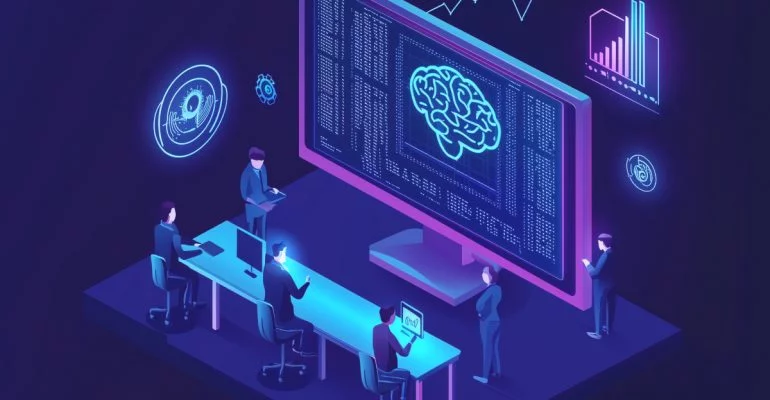In recent years, the rise of generative AI has shifted from theoretical promise to practical impact—especially in the realm of custom software development. As businesses increasingly seek smarter, faster, and more cost-effective digital solutions, generative AI technologies such as GPT-4, Stable Diffusion, and Codex are becoming integral to the software development lifecycle.
In this blog, we’ll explore how generative AI is transforming each stage of custom software development, what it means for your business, and how forward-thinking providers like One Technology Services are embracing these changes to deliver value.

What Is Generative AI?
Generative AI refers to algorithms that can automatically generate text, code, images, audio, and even entire application prototypes based on learned data patterns. Unlike traditional AI that is reactive, generative models are proactive creating new content rather than just analyzing existing data.
Key examples include:
- LLMs (Large Language Models): e.g., OpenAI’s GPT, Google’s Gemini
- Image Generators: e.g., DALL·E, Midjourney
- Code Assistants: e.g., GitHub Copilot, Tabnine
The Traditional Approach to Custom Software Development
Before generative AI, software development typically involved:
- Detailed requirement analysis
- Manual coding by developers
- Extensive prototyping
- Repetitive QA and testing cycles
This process was resource-heavy, time-consuming, and required large teams to handle everything from architecture to deployment.
How Generative AI Is Revolutionizing Custom Development
Let’s break down the transformation across various development stages:
1. Automated Requirements Analysis
Generative AI tools can now translate business documents, emails, or meeting transcripts into detailed software requirements. This speeds up initial discovery, reduces miscommunication, and helps create more accurate development roadmaps.
2. AI-Powered Prototyping and Wireframes
Design tools enhanced with AI like Figma’s AI plugin or Uizard enable instant generation of UI/UX wireframes based on user prompts. This accelerates design iterations and makes early-stage feedback more efficient.
3. Code Generation and Acceleration
Code assistants like GitHub Copilot and Amazon CodeWhisperer help developers write, review, and debug code faster. They suggest real-time completions, automate boilerplate code, and even generate entire functions.
This improves developer productivity by up to 50% and allows smaller teams to deliver enterprise-grade applications.
4. Automated Testing and QA
AI models now write test cases, identify edge cases, and simulate usage scenarios autonomously. This enhances software reliability and shortens QA cycles especially in agile development environments.
5. Smarter DevOps and Deployment
Generative AI supports infrastructure-as-code generation, CI/CD automation scripts, and real-time monitoring with anomaly detection. This makes deployment smoother and more resilient to runtime issues.
Use Cases Across Industries
Healthcare
Custom AI-driven tools for patient monitoring, diagnostics, and backend automation
Finance
Automated fraud detection systems, predictive analytics dashboards, and chatbot interfaces
Retail
AI-based recommendation engines, inventory forecasting systems, and personalized user journeys
Manufacturing
AI-generated predictive maintenance software, supply chain management tools, and AR-driven training systems
In all these sectors, One Technology Services has identified tangible benefits from incorporating generative AI into the custom development workflow.
Challenges to Consider
While generative AI offers immense value, it comes with technical and ethical considerations:
- Bias in AI models: Outputs can reflect training data limitations
- Security risks: Code suggestions may introduce vulnerabilities if not validated
- IP and compliance: AI-generated content may pose ownership or licensing issues
- Over-reliance: Human oversight remains essential to ensure business logic and performance quality
That’s why it’s critical to work with experienced partners who understand both the technology and your industry context.
Why This Matters for Your Business
Speed
Generative AI can shorten development timelines by up to 40% without sacrificing quality.
Cost Efficiency
Fewer development hours and faster cycles reduce the total cost of ownership (TCO).
Innovation Enablement
AI-generated prototypes and rapid iterations encourage experimentation, helping businesses test new ideas with minimal risk.
Talent Augmentation
Even lean in-house teams can build sophisticated apps with the right AI tools.
The Role of One Technology Services
At One Technology Services, we help clients leverage generative AI not just as a tool—but as a strategic enabler of growth. Our custom software development model is evolving to integrate:
- AI-assisted coding environments
- Prompt-engineered automation for faster delivery
- Embedded AI capabilities in final software products
- Ongoing model fine-tuning for long-term value
Whether you’re building a product from scratch or modernizing legacy systems, our AI-first mindset ensures scalable, secure, and innovative solutions aligned to your business needs.
Final Thoughts
Generative AI is no longer a futuristic concept it’s a present-day advantage in the hands of businesses that know how to use it. By reshaping the way custom software is built, tested, and deployed, it offers unmatched potential for innovation, speed, and efficiency.
The key is to adopt AI thoughtfully and partner with teams that blend human expertise with machine intelligence.
Ready to see how AI can supercharge your next custom software project?
Contact One Technology Services today for a consultation.
Read More:
Low-Code and No-Code Platforms: A Game-Changer for Custom Software Development
AI in Marketing: Enhancing Customer Experience with Artificial Intelligence

